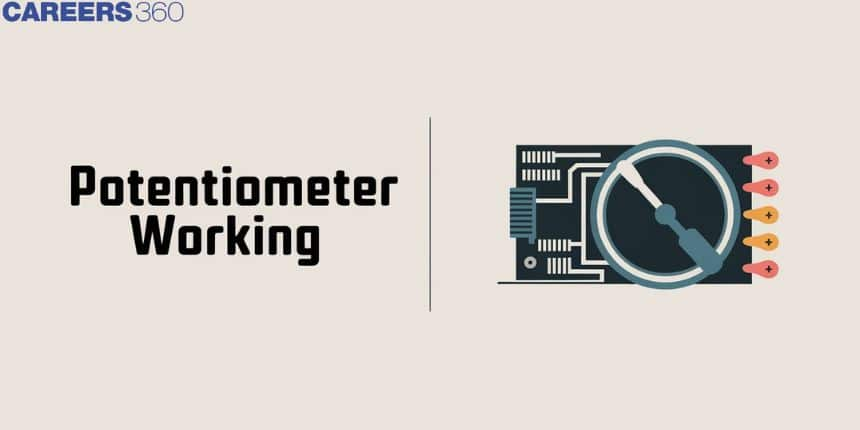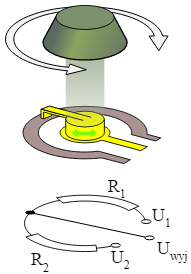Potentiometer Working - Definition, Types, Application, FAQs
A potentiometer is an instrument used to measure the EMF, resistance, and voltage. It works based on the principle of balancing potential differences without drawing electric current. A potentiometer gives highly accurate measurements. In this article, we are going to discuss what is potentiometer class 12, the working principle of potentiometer, potentiometer working, the internal resistance of a cell, types of potentiometer, and application of potentiometer.
New: JEE Main/NEET 2027 - Physics Important Formulas for Class 10
JEE Main 2025: Study Materials | High Scoring Topics | Preparation Guide
JEE Main 2025: Syllabus | Sample Papers | Mock Tests | PYQs | Study Plan 100 Days
NEET 2025: Syllabus | High Scoring Topics | PYQs | Crack NEET in 2 months - Study Plan
- What is a Potentiometer Class 12?
- Working Principle Of Potentiometer and Potentiometer Working
- Internal Resistance of the Cell
- Types of Potentiometer Based on Adjustment Mechanism
- Types of Rotating Potentiometers
- Types of Linear Potentiometer
- Application of Potentiometer

What is a Potentiometer Class 12?
In physics, a potentiometer is an instrument that is made up of three terminal resistors that have sliding or rotating contact that forms a voltage divider and this voltage driver is also adjustable. The potentiometer is used as the rheostat (also known as variable resistor) when it has two terminals that contain one end and a wiper. In short, these potentiometers are also called “pots”. The potentiometer diagram is given below.

Working Principle Of Potentiometer and Potentiometer Working
The potentiometer contains a long resistive wire L, and an EMF battery V. This voltage V is also called driver cell voltage. Consider a primary circuit that is connected to the emf cell. The other end of the circuit is connected to the G, galvanometer. This circuit is considered to be a secondary circuit.
The potentiometer working is based on the potential across the wire and the length of the wire which has a uniform area cross-section and constant current flow that shares a proportionality relation. In short, the principle behind the potentiometer working can be explained as the potential across the wire is directly proportional to the length of the wire. This can be expressed as
Where I denotes the current flow, R denotes the total resistance of the circuit, V denotes the voltage
Where,
When
And
Where,
When the potential difference between the ends is zero, the galvanometer G shows null detection. This denotes that the flow of current in the circuit is also zero. Here, the x is considered to be the length of the null point. Now, unknown EMF is found from the following formula,
As the EMF has two cells, consider
Internal Resistance of the Cell
A cell having unknown resistance (r) is connected in series with a resistance box and key

When
We know that
Substitute
Solving for r,
Substituting
The internal resistance of the cell,
Types of Potentiometer Based on Adjustment Mechanism
Let us see the different types of potentiometers and also discuss them in detail.
- Slider potentiometer (also known as slide potentiometer):
This type of potentiometer is adjustable by sliding the wiper in the right or left direction. - Thumbwheel potentiometer(also known as thumb potentiometer):
This type of potentiometer is adjustable with a small thumbwheel. - Trimmer potentiometer (also known as trim potentiometer):
This type of potentiometer is adjustable by the fine-tuning of some electric signals.
Types of potentiometers based on operation are linear potentiometers and rotating potentiometers.
Types of Rotating Potentiometers
- Concentric potentiometer
- Single turn potentiometer
- Servo potentiometer
Concentric potentiometer
Two different potentiometers are adjustable individually by the concentric shafts. These types of potentiometers are used as control volume in the radios of old cars.
Single-turn potentiometer
This type of potentiometer is adjustable up to 270 degrees with the help of a single rotation. These types of potentiometers are used to control the resolution in a single rotation.
Servo potentiometer
The Servo potentiometer can be adjusted by servo motors automatically. These types of potentiometers are used in the volume control of remote control audio equipment.
|
Related Topics, |
Types of Linear Potentiometer
- Multi-turn slide Potentiometer
- Slide Potentiometer
- Dual slide Potentiometer
Multi-turn slide Potentiometer
In the construction of a multi-turn slide Potentiometer, a spindle is used.
Slide Potentiometer
In the construction of the slide Potentiometer, the high-quality fader is used. This potentiometer is used to measure distance.
Dual slide potentiometer
Dual slide Potentiometers are used to control single and dual sliders which are connected in parallel.
Application of Potentiometer
-
Linear and rotary Potentiometer is used in controlling the audio equipment to adjust the volume of the audio signals.
-
The potentiometer in televisions is used to control the brightness of the picture, colour, and so on.
-
The potentiometers are also used in motion control in position feedback devices like servo motors.
-
The potentiometers used in transducers are used to design the displacement transducers.
-
The potentiometers are used as control volume in the radios of old cars.
Also read:
Frequently Asked Questions (FAQs)
The principle behind the potentiometer working can be explained as the potential across the wire is directly proportional to the length of the wire. This can be expressed as V=IR. In detail, The potentiometer working is based on the potential across the wire and the length of the wire which has uniform area cross section and constant current flow shares a proportionality relation.
A potentiometer is an instrument which is made up of three terminal resistors in which has sliding or rotating contact that forms a voltage divider and this voltage driver is also adjustable. The potentiometer is used as the rheostat (also known as variable resistor), when it has two terminals that contain one end and wiper. In short, these potentiometers are also called “pots”.
In the construction of multi turn slide Potentiometer, a spindle is used. A wheel is attached to the spring which changes the linear position into a variable one.
Linear and rotary Potentiometer is used in controlling the audio equipment to adjust the volume of the audio signals.
The potentiometer in televisions are used to control the brightness of the picture, color, and so on.
The potentiometers are also used in the motion control in position feedback devices like servo motors.
The potentiometers used in transducers are used to design the displacement transducers.
The potentiometers are used as control volume in the radios of old cars.
When the potential difference between the ends is zero, the galvanometer G shows null detection. This denotes that the flow of current in the circuit is also zero. The instrument is used to detect the zero current condition of a circuit, where the voltage between the endpoints are the same.
The potentiometer is constructed to be adjustable with a variable resistor made of 3 different terminals. Two terminals in that are connected such that they are connected to the opposing ends of the resistive element.
There are a lot of potentiometers in practice and each vary from their uses and applications. Some of the potentiometer is listed below:
Multi turn slide Potentiometer
Slide Potentiometer
Dual slide Potentiometer
Thumbwheel potentiometer(also known as thumb potentiometer)
Trimmer potentiometer (also known as trim potentiometer)
Concentric potentiometer
Single turn potentiometer
Servo potentiometer
Also Read
29 Nov'24 09:48 AM
23 Nov'24 01:56 PM
20 Nov'24 10:32 AM
17 Nov'24 10:02 AM
17 Nov'24 09:56 AM
14 Nov'24 07:31 PM
14 Nov'24 05:59 PM
14 Nov'24 01:16 PM
14 Nov'24 12:54 PM

